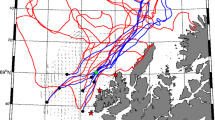Summary
Comparisons of different Lagrangian and Eulerian near surface current measurements in shallow water during the experiment Baltic '75 show a strong influence of winds and surface waves on the measured data. The AMF vector averaging current meter (VACM) recordings and the drifts of dye patches show a reasonable agreement in speed and direction in all observed weather conditions. the Aanderaa current meter reproduces the directions well but increasingly overestimates the speed with increasing wave height. Drifting floats proved to be only usable in calm weather.
In the halocline a value of 2.0 has been observed for the ratios of the energies in the low frequency range obtained from CACM instruments on surface and subsurface moorings. These ratios are constant only during stable weather conditions and scatter largely during periods of quick changes in the windfield. Coherences between the north and east current components at surface moored instruments are significantly overestimated.
Zusammenfassung
Bei einem Vergleich von verschiedenen oberflächennahen Lagrangschen und Eulerschen Strömungsmessungen im Flachwasser während des Experiments Baltic '75 wird ein starker Einfluß von Wind und Seegang auf die gemessenen Größen festgestellt. Die Registrierungen des vektormittelnden Strommessers (AMF) und die Drift von Farbstoffflecken zeigen in allen beobachteten Wettersituationen gute Übereinstimmung in Richtung und Geschwindigkeit. Dagegen ist die registrierte Geschwindigkeit beim Aanderaa-Strommesser mit ansteigender Wellenhöhe zunehmend überhöht, während die Richtungen gut reproduziert werden. Driftkörper ergeben nur bei ruhiger Wetterlage brauchbare Resultate.
Die niederfrequenten Energien, berechnet aus Strommessungen mit VACM's in der Salzgehaltssprungschicht, liegen in Oberflächenverankerungen um einen Faktor 2,0 höher als in Unterwasserverankerungen. Dieses Energieverhältnis ist während stabiler Wetterlagen konstant, in Zeiten schneller Änderungen des Windfeldes treten dagegen starke Streuungen auf. Die Kohärenzen zwischen den Nord- und Ostkomponenten der Strömungen sind an Instrumenten in Oberflächenverankerungen signifikant überhöht.
Résumé
Des comparaisons de différentes mesures Lagrangiennes et Euleriennes de courants de surface en eaux peu profondes effectuées durant l'opération Baltic' 75 montrent une forte influence des vents et des vagues de surface sur les données mesurées. Les enregistrements du courantomètre AMF (qui effectue un certain lissage du vecteur courant) et les dérives de taches de colorant montrent un accord raisonnable en vitesse et direction dans toutes les conditions météorologiques observées. Le courantomètre Aanderaa reproduit bien des directions mais surestime la vitesse de façon croissante à mesure que croît la hauteur des vagues. Les flotteurs dérivants se révèlent utilisables seulement par temps calme.
Dans l'halocline une valeur de 2,0 a été observée pour les rapports des énergies dans les basses fréquences obtenus à l'aide des instruments VACM en mouillage de surface et de subsurface. Ces rapports ne sont constants qu'au cours de conditions météorologiques stables et présentent d'importantes variations pendant les périodes de changements rapides dans le champs du vent. Ces cohérernces entre les composantes nord et est du courant sont surestimées de façon significative par les instruments mouillés en surface.
Similar content being viewed by others
References
Gould, W. J. and E. Sambuco, 1975: The effect of mooring type on measured values of ocean currents. Deep-Sea Res.22, 55–62.
Halpern, D., R. D. Pillsbury and R. L. Smith, 1974: An intercomparison of three current-meters operated in shallow water. Deep-Sea Res.21, 489–497.
Halpern, D. and R. D. Pillsbury, 1976: Influence of surface waves on subsurface current measurerments in shallow water. Limnol. Oceanogr.21, 611–616.
Kielmann, J., J. Holtorff and U. Reimer, 1976: Data report Baltic '75. Ber. Inst. Meeresk. Kiel. Nr. 26, 23 pp.
Kullenberg, G., 1977: Observations of the mixing in the Baltic thermo- and halocline layers. Tellus.29, 572–587.
Quadfasel, D., 1977: Über die Berechnung von Eulerschen und Lagrangeschen Austauschkoeffizienten aus Messungen mit verankerten Strommessern im Experiment BALTIC '75. Dipl.-Arbeit Univ. Kiel, 59 pp.
Saunders, P. M., 1976: Near-surface current measurements. Deep-Sea Res.23, 249–257.
Schott, F., 1974: Über die raumzeitliche Struktur von Stromschwankungen im Meer unter besonderer Berücksichtigung barokliner Gezeiten. Habil.-Schrift, Univ. Kiel, 147 pp.
Schott, F., M. Ehlers, L. Hubrich and D. Quadfasel, 1978: Small-scale diffusion experiments in the Baltic surface mixed layer under different weather conditions. Dt. hydrogr. Z.31, 195–215.
Simons, T. J., 1976: Topographic and baroclinic circulations in the south west Baltic. Ber. Inst. Meeresk. Kiel. Nr. 25, getr. Pag.
Unesco, 1969: An intercomparision of some current meters. SCOR Working Group 21. Unesco Techn. Pap. Mar. Sci.11, 70 pp.
Unesco, 1975: An intercomparison of some current meters III. SCOR Working Group 21. Unesco Techn. Pap. Mar. Sci.23, 42 pp.
Author information
Authors and Affiliations
Rights and permissions
About this article
Cite this article
Quadfasel, D., Schott, F. Comparison of different methods of current measurements. Deutsche Hydrographische Zeitschrift 32, 27–38 (1979). https://doi.org/10.1007/BF02227044
Received:
Published:
Issue Date:
DOI: https://doi.org/10.1007/BF02227044




